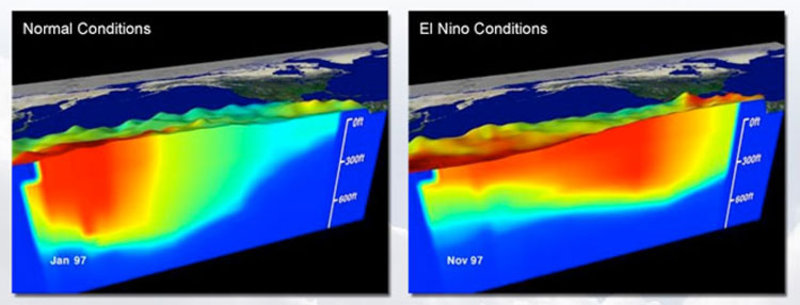What is El Niño?
Scientifically, El Niño refers to unusual sea surface temperatures throughout the equatorial Pacific that result in worldwide weather effects.

These images show sea surface topography and upper ocean temperature data from satellites and buoys. The height of the sea is represented by hills and valleys. Water temperature is shown in color, ranging from 30°C as red to 8°C, shown in dark blue. The image on the left represents "normal" conditions in the equatorial Pacific during January 1997. The image on the right shows El Niño conditions from November 1997. Note the much warmer waters present during the El Niño event. Download image (jpg, 52 KB).
Peruvian fishermen have long noted that in some winters, coastal waters heat up and fish stocks dwindle, a phenomenon they named El Niño, a reference to the birth of the Christ child, which also came in winter.
The name "El Niño" has become familiar to many people as the cause of unpleasant, even extreme, weather. To Californians, it means heavy rains, floods, and mudslides. To Australians, it brings thoughts of drought and catastrophic wildfires. But to meteorologists and oceanographers, El Niño is a fascinating glimpse into the intricate dance of the ocean and the atmosphere and the swirling patterns of heat and moisture that describe the global climate.
An El Niño condition is officially declared by NOAA when a three-month average of sea surface temperatures in the east central equatorial Pacific Ocean is 0.5° C or more above normal. Historically, El Niño occurred about once or twice per decade, but there is some indication that the frequency of these events is increasing.
Severe El Niños cause death and destruction across countries, even continents, and yet the cause and consequences of these events is still not well understood. Only recently has the technology been available to allow scientists to study, model, and begin to predict global weather and climate.